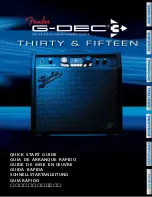
rectly connected or operated, or not repaired in an
expert way.
3
Applications
This PA stereo amplifier has especially been
designed for stage and disco applications. The
amplifier may be operated in stereo mode, in mono
parallel mode, or in mono bridge mode. With its
class H output circuit it operates more efficiently than
standard amplifiers of class AB technology. Due to a
switchable filter the amplifier may also be used only
for subwoofers or only for the frequency range
exceeding 120 Hz. Extensive protective circuits pro-
tect the amplifier and the speakers connected. Two
powerful, temperature-controlled fans supply the
necessary cooling of the amplifier.
4
Setting-Up
The amplifier is provided for installation into a rack
(482 mm/19"), but it may also be used as a table top
unit. In each case air must be allowed to flow freely
through all ventilation slots so that a sufficient cool-
ing is ensured.
4.1
Rack installation
For rack mounting 3 rs (rack spaces) = 133 mm are
required. The heated air blown out by the amplifier at
the rear must be able to dissipate from the rack, oth-
erwise a heat accumulation will occur in the rack
which may not only damage the amplifier but also
other units in the rack. In case the heat is not dissi-
pated sufficiently, insert a fan unit into the rack.
To prevent top-heaviness of the rack, the ampli-
fier must be inserted in the lower part of the rack. To
ensure a safe fixing, the front panel alone is not suf-
ficient. In addition, the unit must be fastened at the
rear side or be supported by means of lateral rails or
a bottom plate.
5
Connecting the Amplifier
All connections must only be made or changed with
the unit switched off!
1) Connect the output of a preamplifier or mixer to
the XLR jacks INPUTS (7). The jacks are
designed for balanced signals; the pin configura-
tion is shown in fig. 2. For connection of sources
with unbalanced signals use an adapter with the
XLR contacts 1 and 3 bridged (e. g. the adapter
MCA-15/2 from “img Stage Line”: 2-pole 6.3 mm
inline jack to XLR plug).
The input signal should have line level. For
rated power of the amplifier an input signal of 1 V
is required as a minimum.
For bridge mode or parallel mode, only con-
nect the input of the left channel L-CH.
Via the feed-through outputs (8) which are
directly connected to the respective input jack (7)
the signal can be fed e. g. to an additional ampli-
fier.
2) The maximum output power is reached in stereo
mode and in parallel mode when connecting 4 Ω
speakers (minimum admissible load impedance
at rated power). It is also possible to connect 8 Ω
speakers, however, in this case the output power
will slightly decrease. In bridge mode the maxi-
mum output power will be reached with an 8 Ω
speaker (minimum admissible load impedance at
rated power in bridge operation). The required
power rating (P
MIN
) of the speakers is listed in the
table fig. 3.
As long as in stereo or parallel operation the
RMS output power of 1250 W per channel is not
exceeded, the operation with 2 Ω load is possible.
A bridge operation at a 4 Ω load is possible up to
an RMS output power of 2500 W.
Connect the speakers to the Speakon® jacks.
Fig. 2 shows the pin configuration of the plug; the
contact pairs 1+/1- and 2+/2- are connected in
the unit with each other in each case.
After connecting a Speakon
®
plug to the jack,
turn it clockwise until it locks into place. For
removing it later, retract the latch lock at the plug
and turn the plug counter-clockwise.
When connecting the speakers, pay attention
to the same polarity of all speakers.
For
stereo mode or parallel mode
connect
the speakers to the Speakon
®
jacks L-CH (13)
and R-CH (12). For
bridge mode
connect the
speaker to the Speakon
®
jack BRIDGE (15).
Table fig. 3 also shows
possibilities of con-
nection for several speakers
to one output. In
each case it is stated which power rating (P
MIN
)
each speaker must have as a minimum with the
corresponding impedance (Z). When intercon-
necting several speakers, special attention has to
be paid to the correct connection of the positive
and negative terminals.
Important:
At rated power, the total impedance
at each output must not fall below 4 Ω in stereo
and parallel operation, and 8 Ω in bridge opera-
tion!
As long as in stereo or parallel operation the
RMS output power of 1250 W per channel is not
exceeded, the operation with 2 Ω load is possible.
A bridge operation at a 4 Ω load is possible up to
an RMS output power of 2500 W.
3) The unit is supplied without a mains cable. For
connection, use a mains cable with a PowerCon
®
plug (NAC3FC-HC = 32 A type) and a mains plug
with earthed contact. The mains cable AAC-215P
from “img Stage Line” with an earthed plug for the
If the unit is to be put out of operation defin-
itively, take it to a local recycling plant for a
disposal which is not harmful to the envi-
ronment.
D
A
CH
5
GB
resultierende Sach- oder Personenschäden und
keine Garantie für das Gerät übernommen werden.
3
Einsatzmöglichkeiten
Dieser PA-Stereo-Verstärker ist speziell für den Ein-
satz auf der Bühne und in der Diskothek konzipiert.
Er kann im Stereobetrieb, im Mono-Parallelbetrieb
oder im Mono-Brückenbetrieb genutzt werden. Mit
seiner Class-H-Ausgangsschaltung arbeitet er effi-
zienter als herkömmliche Verstärker in Class-AB-
Technologie. Durch ein schaltbares Filter kann der
Verstärker auch nur für Subwoofer oder nur für den
Frequenzbereich oberhalb von 120 Hz eingesetzt
werden. Umfangreiche Schutzschaltungen schützen
den Verstärker und die angeschlossenen Lautspre-
cher. Zwei leistungsstarke, temperaturgeregelte Lüf-
ter sorgen für die nötige Kühlung des Verstärkers.
4
Aufstellmöglichkeiten
Der Verstärker ist für den Einschub in ein Rack
(482 mm/19") vorgesehen, kann aber auch als
Tischgerät ver wendet werden. In jedem Fall muss
Luft ungehindert durch alle Lüftungsschlitze strömen
können, damit eine ausreichende Kühlung gewähr-
leistet ist.
4.1
Rackeinbau
Für die Rackmontage werden 3 HE (Höheneinhei-
ten) = 133 mm benötigt. Die vom Verstärker rücksei-
tig ausgeblasene, erhitzte Luft muss aus dem Rack
austreten können. Anderenfalls kommt es im Rack
zu einem Hitzestau, wodurch nicht nur der Verstär-
ker, sondern auch andere Geräte im Rack beschä-
digt werden können. Bei unzureichendem Wärme-
abfluss in das Rack eine Lüftereinheit einsetzen.
Damit das Rack nicht kopflastig wird, muss der
Verstärker im unteren Bereich des Racks einge-
schoben werden. Für eine sichere Befestigung
reicht die Frontplatte allein nicht aus. Zusätzlich
muss das Gerät an der Rückseite befestigt oder
über Seitenschienen oder eine Bodenplatte gehal-
ten werden.
5
Verstärker anschließen
Alle Anschlüsse dürfen nur bei ausgeschaltetem
Gerät hergestellt oder verändert werden!
1) An die XLR-Buchsen INPUTS (7) den Ausgang
eines Vorverstärkers oder eines Mischpults
anschließen. Die Buchsen sind für symmetrische
Signale beschaltet; die Kontaktbelegung ist in
Abbildung 2 dargestellt. Für den Anschluss von
Quellen mit asymmetrischen Signalen einen
Adapter verwenden, bei dem die XLR-Kontakte 1
und 3 gebrückt sind (z. B. den Adapter MCA-15/2
von „img Stage Line“: 2-polige 6,3-mm-Klinken -
kupplung auf XLR-Stecker).
Das Eingangssignal sollte Line-Pegel aufwei-
sen. Für eine Vollaussteuerung des Verstärkers
ist ein Eingangssignal von mindestens 1 V erfor-
derlich.
Für den Brücken- oder Parallelbetrieb nur den
Eingang des linken Kanals L-CH anschließen.
Über die Durchschleifausgänge (8), die mit
der jeweiligen Eingangsbuchse (7) direkt verbun-
den sind, kann das Signal z. B. zu einem zusätz-
lichen Verstärker weitergeleitet werden.
2) Die größte Ausgangsleistung wird im Stereobetrieb
und im Parallelbetrieb beim An schluss von 4-Ω-
Lautsprechern (minimal zulässige Lastimpedanz
bei Vollaussteuerung) erreicht. Es können auch
8-Ω-Lautsprecher angeschlossen werden, was
die Ausgangsleis tung aber etwas verringert. Im
Brückenbetrieb wird die größte Ausgangsleistung
mit einem 8-Ω-Laut sprecher (minimal zulässige
Lastimpedanz bei Vollaussteuerung im Brücken-
betrieb) erreicht. Die erforderliche Nenn
belast-
barkeit (P
MIN
) der Lautsprecher ist in der Tabelle
Abb. 3 aufgeführt.
Solange im Stereo- oder Parallelbetrieb die
Sinus-Ausgangsleistung von 1250 W pro Kanal
nicht überschritten wird, ist auch der Betrieb mit
2-Ω-Lasten möglich. Ein Brückenbetrieb an einer
4-Ω-Last ist bis zu einer Sinus-Ausgangsleistung
von 2500 W möglich.
Die Lautsprecher an die Speakon
®
-Buchsen
an schließen. Die Kontaktbelegung des Steckers
ist in Abb. 2 gezeigt; die Kontaktpaare 1+/1- und
2+/2- sind im Gerät jeweils miteinander verbun-
den.
Einen Speakon
®
-Stecker nach dem Einste-
cken in die Buchse nach rechts drehen, bis er
einrastet. Zum späteren Herausziehen den
Sicherungsriegel am Stecker zurückziehen und
den Stecker nach links drehen.
Beim Anschluss der Lautsprecher ist auf die
gleiche Polung aller Lautsprecher zu achten.
Für den
Stereo- oder Parallelbetrieb
die
Lautsprecher an die Speakon
®
-Buchsen L-CH
(13) und R-CH (12) anschließen. Für den
Brü-
ckenbetrieb
den Lautsprecher an die Speakon
®
-
Buchse BRIDGE (15) anschließen.
In der Tabelle Abb. 3 sind auch
Anschluss-
möglichkeiten für mehrere Lautsprecher
an
einem Ausgang aufgeführt. Dazu ist jeweils
angegeben, welche Nennbelastbarkeit (P
MIN
)
jeder Lautsprecher bei entsprechender Impe-
danz (Z) mindestens haben muss. Beim Zusam-
menschalten von mehreren Lautsprechern ist
besonders auf die richtige Verbindung der Plus-
und Minusanschlüsse zu achten.
Wichtig:
Die Gesamtimpedanz an jedem Aus-
gang darf bei Vollaussteuerung im Stereo- und
Soll das Gerät endgültig aus dem Betrieb
genommen werden, übergeben Sie es zur
umweltgerechten Entsorgung einem örtli-
chen Recyclingbetrieb.
Summary of Contents for 25.0500
Page 19: ...19 ...






































